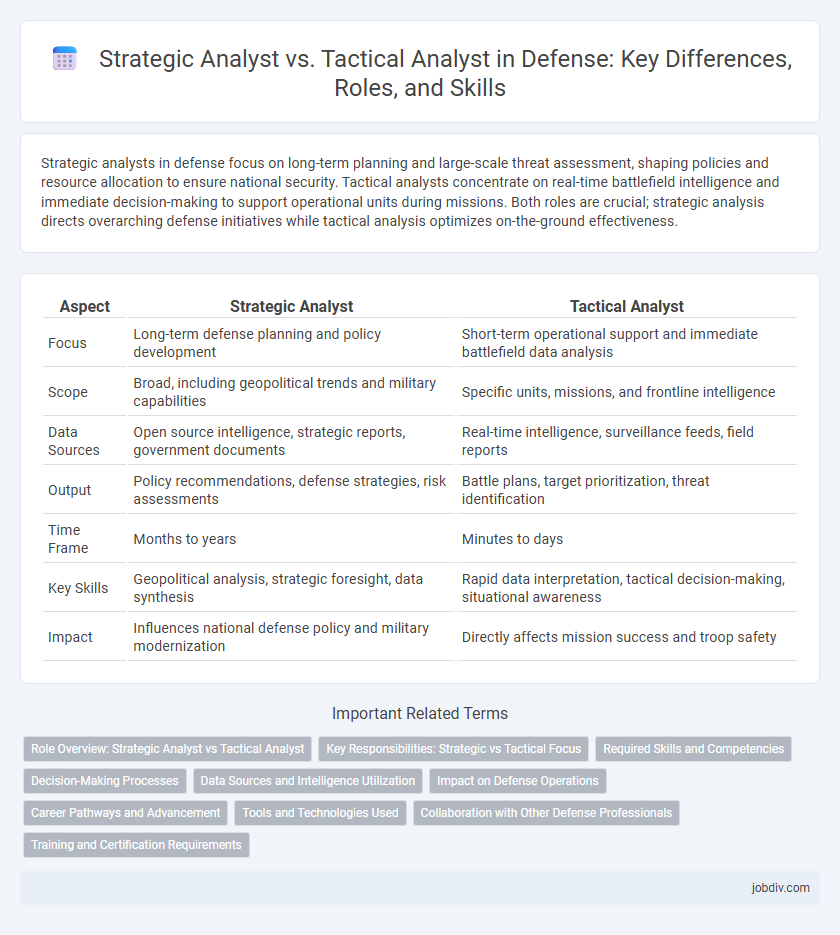Strategic analysts in defense focus on long-term planning and large-scale threat assessment, shaping policies and resource allocation to ensure national security. Tactical analysts concentrate on real-time battlefield intelligence and immediate decision-making to support operational units during missions. Both roles are crucial; strategic analysis directs overarching defense initiatives while tactical analysis optimizes on-the-ground effectiveness.
Table of Comparison
| Aspect | Strategic Analyst | Tactical Analyst |
|---|---|---|
| Focus | Long-term defense planning and policy development | Short-term operational support and immediate battlefield data analysis |
| Scope | Broad, including geopolitical trends and military capabilities | Specific units, missions, and frontline intelligence |
| Data Sources | Open source intelligence, strategic reports, government documents | Real-time intelligence, surveillance feeds, field reports |
| Output | Policy recommendations, defense strategies, risk assessments | Battle plans, target prioritization, threat identification |
| Time Frame | Months to years | Minutes to days |
| Key Skills | Geopolitical analysis, strategic foresight, data synthesis | Rapid data interpretation, tactical decision-making, situational awareness |
| Impact | Influences national defense policy and military modernization | Directly affects mission success and troop safety |
Role Overview: Strategic Analyst vs Tactical Analyst
A Strategic Analyst in defense focuses on long-term threat assessment, geopolitical trends, and policy implications to inform high-level decision-making and resource allocation. In contrast, a Tactical Analyst concentrates on real-time battlefield intelligence, target identification, and immediate operational support to enhance mission effectiveness. Both roles are critical, with Strategic Analysts guiding overarching defense strategies and Tactical Analysts ensuring agile responses to dynamic combat scenarios.
Key Responsibilities: Strategic vs Tactical Focus
Strategic analysts in defense focus on long-term planning, assessing geopolitical trends, and guiding policy development to inform national security objectives. Tactical analysts concentrate on real-time battlefield intelligence, evaluating immediate threats, and supporting mission execution with actionable data. Both roles are essential for comprehensive defense strategy, balancing foresight with operational responsiveness.
Required Skills and Competencies
Strategic analysts in defense require strong competencies in long-term planning, geopolitical analysis, and understanding of international security frameworks, enabling them to anticipate threats and shape defense policies. Tactical analysts focus on skills such as data interpretation from battlefield intelligence, rapid decision-making, and operational coordination to support immediate mission objectives. Both roles demand proficiency in critical thinking and defense technology, but strategic analysts prioritize foresight and policy integration while tactical analysts excel in situational awareness and execution.
Decision-Making Processes
Strategic analysts evaluate long-term defense objectives by assessing geopolitical trends, resource allocations, and policy implications to guide high-level military planning and national security decisions. Tactical analysts focus on real-time battlefield data, enemy movements, and immediate operational gains to inform commanders' quick, situational decisions. Both roles integrate intelligence and risk assessment, but strategic analysts shape overarching defense doctrines while tactical analysts optimize frontline effectiveness.
Data Sources and Intelligence Utilization
Strategic analysts primarily leverage macro-level data sources such as geopolitical trends, global intelligence reports, and long-term threat assessments to inform defense policy and national security strategies. Tactical analysts focus on real-time, mission-specific intelligence from sources like battlefield surveillance, signals intelligence (SIGINT), and human intelligence (HUMINT) to support operational decisions and immediate tactical responses. Both roles utilize intelligence but differ in scope and temporal focus, with strategic analysis shaping overarching defense initiatives and tactical analysis driving in-field action.
Impact on Defense Operations
Strategic analysts assess long-term threats and global defense trends, enabling military leadership to formulate policies and allocate resources effectively for future conflicts. Tactical analysts concentrate on real-time battlefield intelligence and immediate mission support, directly influencing operational decisions and troop movements. Together, their integrated analysis enhances situational awareness and optimizes defense operations from high-level strategy to on-the-ground execution.
Career Pathways and Advancement
Strategic Analysts in defense focus on long-term threat assessment and policy planning, often advancing into senior roles such as defense policy advisors or intelligence directors due to their expertise in global security trends. Tactical Analysts concentrate on immediate battlefield information and operational support, progressing towards positions like operations commanders or tactical intelligence officers with hands-on decision-making responsibilities. Career pathways for Strategic Analysts generally involve advanced education and interagency collaboration, while Tactical Analysts prioritize field experience and real-time data interpretation for rapid response.
Tools and Technologies Used
Strategic analysts utilize advanced data analytics platforms, geospatial intelligence systems, and predictive modeling tools to assess long-term threats and develop comprehensive defense policies. Tactical analysts rely heavily on real-time surveillance technologies, battlefield management systems, and communication intercept tools to support immediate operational decision-making. Both roles integrate artificial intelligence and machine learning for enhanced situational awareness, yet their technological focus varies by time horizon and mission scope.
Collaboration with Other Defense Professionals
Strategic analysts collaborate closely with military planners, intelligence officers, and policymakers to develop comprehensive defense strategies that align with long-term national security goals. Tactical analysts work alongside field commanders, operations officers, and intelligence units to provide real-time data analysis and actionable insights for immediate battlefield decision-making. Effective collaboration between strategic and tactical analysts enhances the synchronization of defense operations, ensuring that high-level strategies are informed by on-the-ground realities and tactical actions support overarching objectives.
Training and Certification Requirements
Strategic analysts in defense typically require advanced degrees in international relations or security studies and certifications such as Certified Defense Analyst (CDA), focusing on broad geopolitical trends and long-term threat assessments. Tactical analysts prioritize hands-on military training, certifications like Tactical Intelligence Specialist (TIS), and expertise in real-time battlefield data analysis for immediate operational support. Both roles demand continuous education, but strategic analysts emphasize policy and global strategy, while tactical analysts concentrate on actionable intelligence and mission-specific training.
Strategic Analyst vs Tactical Analyst Infographic

 jobdiv.com
jobdiv.com